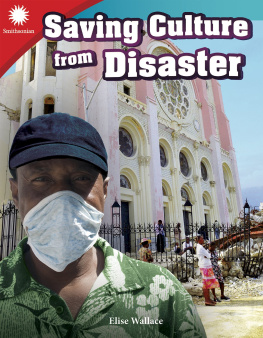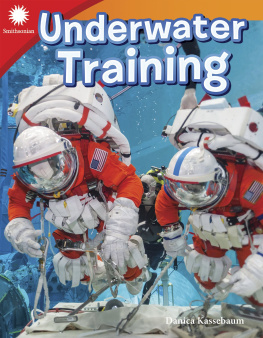
Elise Wallace
2019 Smithsonian Institution. e name Smithsonian and the Smithsonian
logo are registered trademarks owned by the Smithsonian Institution.


Contributing Author
Allison Duarte, M.A.
Consultants
Tamieka Grizzle, Ed.D.
K5 STEM Lab Instructor
Harmony Leland Elementary School
Corine Wegener
Cultural Preservation Heritage Officer
Smithsonian
Publishing Credits
Rachelle Cracchiolo, M.S.Ed., Publisher
Conni Medina, M.A.Ed., Managing Editor
Diana Kenney, M.A.Ed., NBCT, Content Director
Vronique Bos, Creative Director
June Kikuchi, Content Director
Robin Erickson, Art Director
Seth Rogers, Editor
Mindy Duits, Senior Graphic Designer
Smithsonian Science Education Center
Image credits: front cover, p.1 Claudiad/iStock; pp.23 Arindam Banerjee/
Shutterstock; p.4, p.5 (all), p.8, p.9, p.11 (all), p.12, p.13 (top), p.15, p.16 (left), p.16
(bottom right), p.17 Smithsonian; pp.67 1001 Nights/iStock; p.16 (right) Imagist/
Shutterstock; p.19 (left) Jimmy Kets/Reporters/Science Source; p.20, p.23 (top)
Katya Kazakina/Bloomberg via Getty Images; p.21 Barbara Morgan/Getty Images;
p.22 FashionStock/Shutterstock; p.24 Bettmann/Getty Images; p.25 Soeren Stache
Deutsche Presse-Agentur/Newscom; p.26 Danny Lawson/PA Images via Getty
Images; p.27 Ed Lallo/Zuma Press/Newscom; all other images from iStock and/or
Shutterstock.
Library of Congress Cataloging-in-Publication Data
Names: Wallace, Elise, author.
Title: Saving culture from disaster / Elise Wallace.
Description: Huntington Beach, CA : Teacher Created Materials, [2018] |
Audience: K to grade 3. | Includes index.
Identiers: LCCN 2017060489 (print) | LCCN 2017061410 (ebook) | ISBN
9781493869213 (e-book) | ISBN 9781493866816 (pbk.)
Subjects: LCSH: Disaster relief--Juvenile literature. | Cultural
property--Protection--Juvenile literature. | Natural disasters--Juvenile
literature.
Classication: LCC HV553 (ebook) | LCC HV553 .W35 2018 (print) | DDC
363.34/8--dc23
LC record available at https://lccn.loc.gov/2017060489
5301 Oceanus Drive
Huntington Beach, CA 92649-1030
www.tcmpub.com
ISBN 978-1-4938-6681-6
2019 Teacher Created Materials, Inc.
2019 Smithsonian Institution. The name Smithsonian
and the Smithsonian logo are registered trademarks
owned by the Smithsonian Institution.
Synched Read-Along Version by:
Triangle Interactive LLC
PO Box 573
Prior Lake, MN 55372
ISBN-13: 978-1-6845-2055-8 (ebook)

Table of Contents
Protecting the Past .........................................
Haiti Earthquake
............................................
Hurricane Katrina
........................................
Superstorm Sandy .........................................
Art Emergency
..............................................
STEAM Challenge
........................................
Glossary
.........................................................
Index
..............................................................
Career Advice................................................

Protecting the Past
The past is all around us . It can be found in art and
in buildings . It can even be found in street signs and in
personal items . History is everywhere you look . But
what happens when there is a disaster , such as a flood
or an earthquake ? History can be lost . It can be washed
away . That is why it is key to protect the past during
times of crisis .
People called conservators (kuhn-SUHR-vuh-tuhrz)
visit places hit by disasters . They look for items that
represent the local culture . The items might be pieces
of art . Or they might be parts of buildings or items from
a destroyed museum .
Conservators know the importance of the past .
They know that the past tells us where we have been .
The past reminds us of our
progress . It tells us how
our culture has grown
and changed.
A conservator carries
art pulled from rubble.

A conservator looks
Conservators work to save
art after an earthquake .
at an iron sculpture
under a microscope .

Haiti Earthquake
Conservators work in tough places . They work in places
that have had major disasters . In 2010 , Haiti (HAY-tee)
faced great loss . A strong earthquake shook the ground . It
knocked down many buildings .
Haiti has a big population . Most of the people who live
there are poor . Many of them do not have jobs . They were
not prepared to deal with a disaster .
Over 200,000 people died in the quake . Many were left
homeless . But it was not just lives and homes that were
lost . Culture was also lost . Museums were destroyed.
Libraries and churches were ruined . Each of these
places was home to books and artwork . Much
of the countrys culture was lost . But
some things were saved . Conservators
worked hard to find and save key pieces
of culture.

Almost one-third of the
people in Haiti were
affected by the earthquake.

Conservators focused their work on a few sites . One of
those sites was a church . It was home to murals . These
murals were works of art . They had been painted on the walls
of the church by famous Haitian (HAY-shuhn) artists .
Only three murals were left after the earthquake . They
were badly damaged . Saving them would not be easy .




























